
Rebecca McGuire-Snieckus
Postcard from Montreal
Posted on November 11, 2019
By Thorne Bailey The first day I woke up in Montreal was to the sound of drums celebrating Canada Day. Outside, there were carnivals and parades throughout the city, all celebrating the cultures, communities and people who live in Montreal. In the evening, I joined the others from the seminar to go out and explore the celebrations, which gave us all a good chance to get to know each other before the seminar began. We headed out to get some drinks and watch the fireworks for Canada Day. Montreal had a vibrant feeling, and Canada Day brought out a festival atmosphere on the streets.
The fireworks were underwhelming, and according to the locals the previous years have been much better, but it was a good bonding experience nonetheless and I went to bed excited for the next two weeks. Day two was a day of introductions; to the seminar, to the rest of the group and meeting Patrick Leroux, the seminar leader, along with some of the staff behind the scenes. There was a huge range of nationalities at the seminar, from Canada to Haiti, Colombia, Brazil and Taiwan, the USA, Netherlands and me from the UK. I made friends with a man from New York City and a woman from the Netherlands. This multicultural element of the seminar brought many different aspects and discourses of circus into one room, and lead to many great discussions.
The rest of this week passed in a blur of seminars on Circus History, Circus Dramaturgy, how to research with/about Circus and what is Research Creation/Practice as Research (PAR). The afternoons were spent either with a few hours in the studio for us to begin our own research, or with talks from companies such as Cirque Hors Pist. They are a social circus in Montreal, who offer an inclusive and alternative space for young marginalized people. It raised interesting conversations about the importance of circus for those who feel they have nowhere else to go. They are seen as an ‘other’ and the circus is often seen as an ‘other’, and because of this it can easily feel like home. They aim to create a place to bond and find a creative outlet, gaining confidence and to develop social connections. It was, for me, eye opening to see how powerful and how important social circuses are and can be. In the evenings we went to shows, including Spring by Gandini Juggling & Alexander Whitley, which I thought was a beautiful merging of juggling and dance. It included an after-show Q&A lead by Patrick that delved into the motives behind the piece. During this, they discussed how they created it, how long it took and if the music was written before or after the material. (Answer: it ‘emerged alongside it’, but was the most contentious part of the whole show.)
I was asked to choose a question I wanted to research during the seminar. I wasn’t immediately sure what I wanted to research, and so went through a few different ideas. Here is the evolution of my research question: Idea 1: How little can I do on stage and it still be considered ‘juggling’? Idea 2: During a juggling piece, what do the audience watch most, the performer or the object? Idea 3: Does the focus of the audience change depending on what the object being thrown is? Idea 4: Where is the point of intersection between moving an object and juggling? Idea 5: When is an object seen as a juggling object? Idea 6: What even is juggling? All of these thoughts made me really understand what my lecturer meant when he said that PAR moves in two opposing directions at once: the exterior void of absolute possibility, and the interior void of the soul.
Throughout the seminar my feelings about my research seemed to come in waves that could be roughly described as ‘oh my god, yes!’ and ‘oh god, help.’ For some of this week I began juggling with and throwing ideas around with a few other artists that had questions along a similar train of thought. Which lead me to decide that I would research a variation of idea 4: ‘Where is the point of intersection between moving an everyday object and that object becoming a juggling object?’
The week ended with a juggling workshop lead by Sean Gandini on rhythm, polyrhythms, and juggling. It was mind-blowing. Coming from an amateur juggling background, it was really cool to see how far Gandini has researched juggling, whether intentional ‘research’ or just ‘practicing’ (which in itself is research). You could just tell he had complete understanding of the beats and rhythms possible with one, two, and three balls (and, more likely, more, however, we stopped at three on the workshop, because we were definitely not good enough). Then it was on to watch Bosch Dreams by Les 7 Doigts de la Main, a show that delved into the surrealist art of Bosch. I personally did not think that highly of this piece. It felt like it had a big budget that was spent on set and technology. Perhaps I think this because I walked in expecting to be blown away, due to the association of the name Les 7 Doigts, and was not. Had it been a smaller less known company, perhaps I would have thought more of it. That being said, they used technology and projection well, with two off-set mesh screens to project onto which allowed the performers behind them to still be seen whilst having images overlaid in front of them. It was pretty damn cool. I also may not have taken as much from it as some people because it was wholly performed in French, and because of this I did not follow the narrative particularly well. All this being said, it received a standing ovation from most of the audience. So, although it may not have been my cup of tea, it was certainly a winner for some people. It hit home for me that if one person doesn’t like my work, it doesn’t mean it’s not good; personal taste is very varied and knowing this means I just have to find my audience. It gives me confidence that making performance content in the future doesn’t have to fit everybody’s taste buds, as it were. We had the weekend off from the seminar, but definitely not ‘off’ all together. After all, there was Montréal Cirque Festival going on. I went to Saint Denis, the highstreet packed with outdoor shows to see what I could find. I was not disappointed. They had timetabled busking spots entertaining the crowds all along the street. I was with someone from our seminar group and he knew one of the buskers, so we got talking to him about how he started busking. I had assumed they were booked by the festival but only made money from what they could hat from the crowds. I was only partly right; he was saying ‘no, email in a video of your act, and get talking to them. If they book you, they’ll pay you to be here. It’s not much but add it to what you can hat and it will easily cover your flights and accommodation for your time here’. I’ve never busked, but it certainly made me wonder if I could! It really changed my perspective of what busking is, and how it can feed into arts festivals too, and made me appreciate that arts festivals gain a lot from having buskers.
A group of us went to see Se Prendre, and it blew me away. Seeing the intimate connection of two performers doing acrobatics less than a meter away, watching the sweat drip down their faces, the micro-expressions you would normally lose on a stage and the surrealist narrative brought it onto another level. It was set in their friends apartment in a secret location that we were sent on the day of the show, we entered the house and sat on the sofa in the kitchen/diner and waited. Once the show began, they lead us through the apartment fitting the fifteen audience members imaginatively into each room, whilst having space to perform in the room too. It conveyed every relatable aspect a relationship has; the joy and naïve open love at the start, the arguments, the silent-stillness after an argument, the comfortability of each other’s embrace, the connection and silliness that comes with living with someone, and the never ending happiness and calm. It is one of the most powerful shows I have ever seen. A few top bits for me:
- For this to make sense you first need to know that the sitting room had five entrances and exits. One door into the bathroom (which lead to a bedroom as an en-suit), a door into the bedroom, and down the hall lead to the front door and both bedrooms. They used this really beautifully. They would walk as if looking for each other, going out of one door, a pause and in through another door, just missing the other performer who had just left the room through a different door. This continued until there is a knock on the front door and Claudel is there looking through.
- Their use of the space. Because they didn’t have the normal stage height to do hand-to-hand, it meant they had to adapt a lot of their moves, but for me this just made it even more interesting. One image that has really stuck in my mind was when they were in a shoulder balance, Claudel upside down on Cooper’s shoulder. Both walking, Cooper from one side of the sitting room to the other and Claudel mirroring on the ceiling. They created a whole scene in which Claudel traversed and moved around the space using the door frames, walls, windowsills and Cooper.
- The final image of the show; in the alleyway behind the apartment, Claudel and Cooper still in their swimmers from their scene in the shower, walking slowly away into the darkness. Made prominent and memorable by the passers-by looking bemused, a dog barking and a cat jumping down from the wall on the left, darting across the alley and disappearing over the wall on the right.
Sunday was a trip to find more street shows (there weren’t any on yet, I was too early) so I took a stroll around Montreal until I needed to meet people at the 7 Doigts new space. It was their welcoming/new space party. Within their walls they have a few different spaces from huge training halls, to small meeting rooms and offices, from a rooftop terrace to an open plan modern kitchen in which the team can meet and eat together. I was pretty blown away to say the least! It was a special occasion, and one that I feel very humbled to have been there for. It felt like a family had just bought their dream home and were celebrating with everyone they knew. The evening party started by walking onto the stage through the fridge of their original set from Loft, their first production. Once everyone was in, the original 7 came on stage and began a scene from Loft, froze on stage, and began joking they were too old to still be doing this; and called out the next generation who took over from their positions and carried on the scene to the end. Then there was a lot of talking (mainly in French) and finishing the night with a lot of drinking and partying.
On the amazing rooftop of the 7 Fingers building The afternoons of that week were spent continuing our research into our questions. I was working largely with Ayal, a flying trapeze artist and Leanne, a juggler/balancer. We were exploring material that merged everyday objects, stanchions, with objects typically understood as ‘juggling objects’: balls. A lot of our time was enjoyably spent creating material and new patterns that used one, two, or three people and as many objects as we could manage. It certainly didn’t feel like ‘research’ and I think this is what bonded us quite quickly, it felt more like a creation process, playing with ideas and discussing the relevance. We’d film the material we came up with and at the end of each research session we’d sit down and chat about it, how it relates to our research or how it has affected our research question. Sometimes jugglers mindlessly balance things when they’re talking about their ideas The afternoon on Wednesday we went to a panel discussion on the Hybridity of Contemporary Circus with panellists: Jedediah Wheeler (executive Director, Arts & Cultural Programing Montclair State University), Brigitte Poupart (Actress and director Transetheatre), Yaron Lifschitz (Artistic Director of Circa) and Samuel Tetreault (Director of Bosch Dreams and one of the artistic directors of 7 Fingers), and facilitated by Patrick Leroux (our seminar leader, the associate dean Concordia University). It was insightful and gave food for thought. Tetreault spoke about how contemporary circus is the dialogue and hybridisation between art forms. One of his main focuses is to seek new hybrid languages through different art forms. I think this is particularly interesting because I spent a large portion of my time creating a new language of movement with cyr wheel that integrated other objects. I found I was hybridising physical theatre with my cyr wheel ability. Jedediah Wheeler said something that really stuck with me though. It made me wonder how I can go about educating my audiences without alienating them. He talked about how he is ‘creating audiences one person at a time’, educating them in ways to watch shows. He believes: audiences must be challenged through shows, performances are research, and insecurity with work is natural – both for the audience and performer.
I stressed and stressed about my final presentation for the seminar. I had to present my findings, or my lack of findings, in a twenty-minute presentation alongside my two researchers. I definitely turn into a perfectionist at times like that. It needed to be in-depth, well thought-out and ‘academic’ enough for a seminar on circus research, or so I thought. I definitely over-stressed. The presentation day showed a massive range in styles. One group performing a full twenty-minute piece that looked into immigration, others that presented with a powerpoint and a mix in between. Our trio decided to perform our researched material to begin with, and then each speak for six minutes on what we found through our practice. I think I overestimated how academic other groups’ presentations were going to be and had made mine very wordy and laden with theory to compensate, which I very quickly realised once people started presenting their research. This aside, I felt really good about what I had achieved in the two weeks in Montreal. It was an incredible experience, one that has enriched my life more than I am yet aware. One lasting legacy will definitely be the people I met during my time there, for which I will be forever thankful I met. Here’s most (some had to leave early) of our seminar cohort: Other notable, but not written about things we did and experienced, in pictures: Talks from Claudel and Cooper from Se Prendre about their show. For example, how it was made, what drove them to make it, their backgrounds and any questions we had about it. A seminar/lecture on the history of Gandini Juggling and where he started. Which also lead into questions about Spring and his other works. It consisted of a lot of watching videos from his archives including him and his company in the 80’s doing the first contemporary dance + juggling blend.
A trip to École nationale de cirque, the national circus school in Montreal.
They have an impressive collection of books on circus, performing arts, history and everything in between, including lots of MA and PhD dissertations. A trip around the Cirque Du Soleil Head Quarters.
The whole team is there (or a lot of it anyway!). A highlight for me was going through the costume department and seeing the archived costumes and the new ones being designed and made. They buy in only white material and dye it to the colour they need it and then make it into the costumes, all within the site. They also dye the soles of the shoes performers where to darker colours so they’re less noticeable to an audience – again within the HQ building. While we were there their main creation space was being used by their new production Messi 10 – which has just opened in Barcelona.
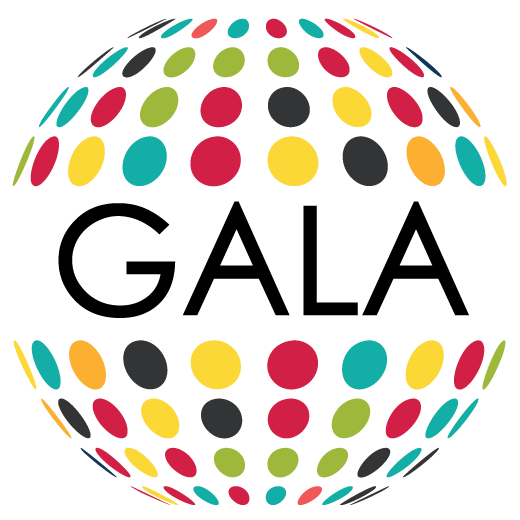

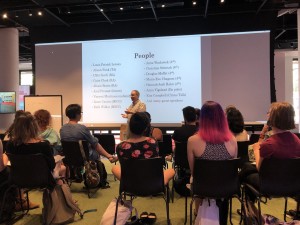
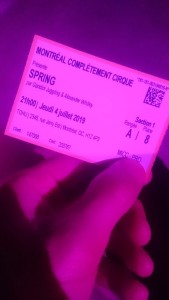
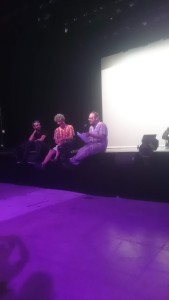
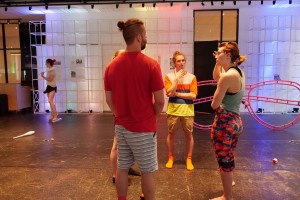
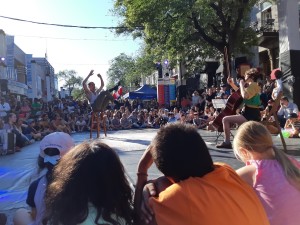
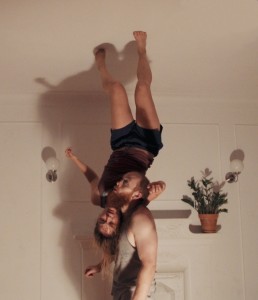


Responses